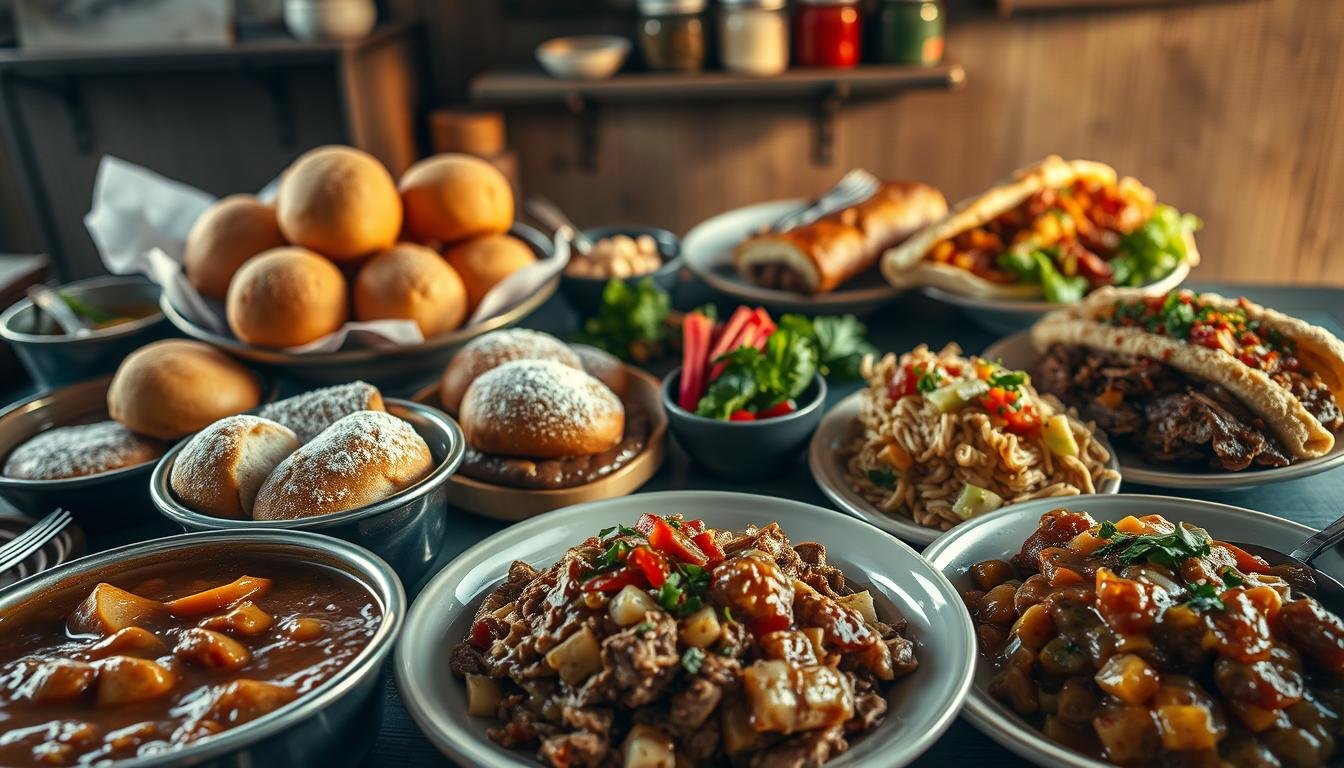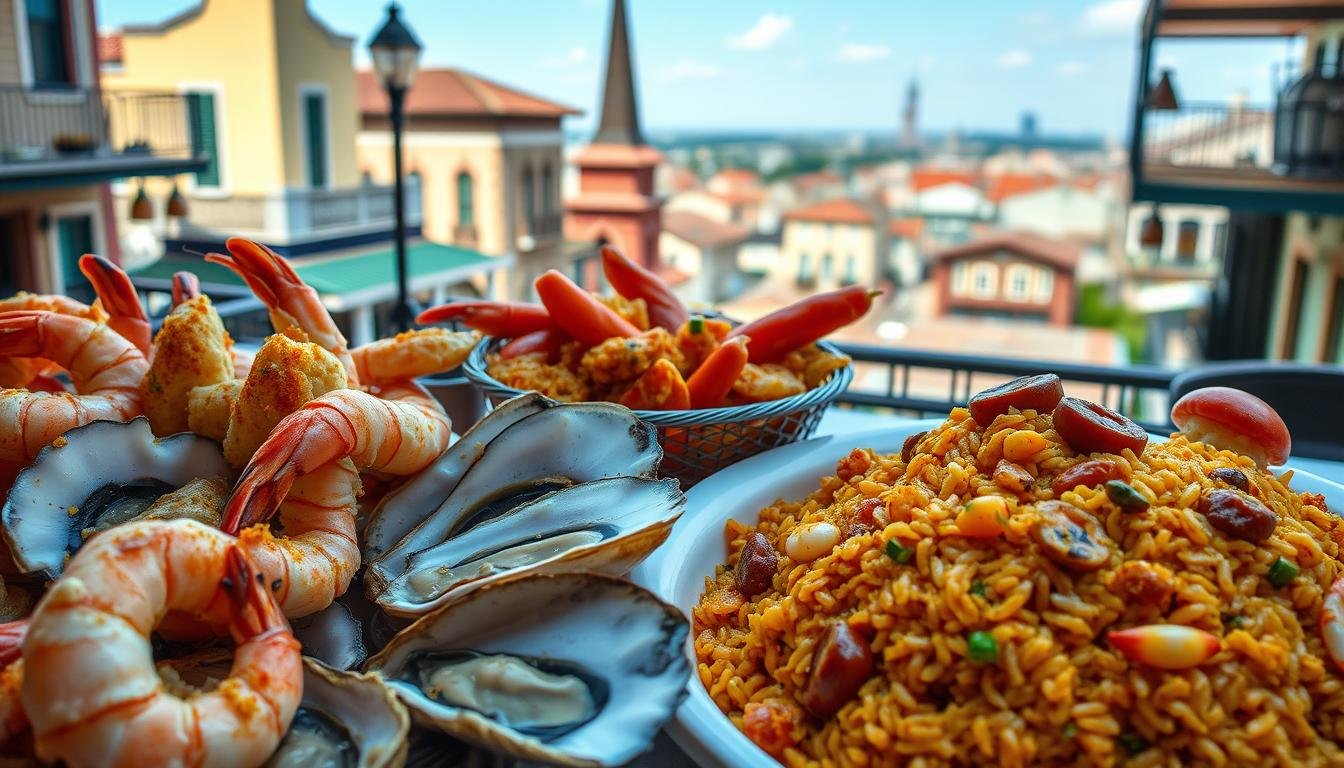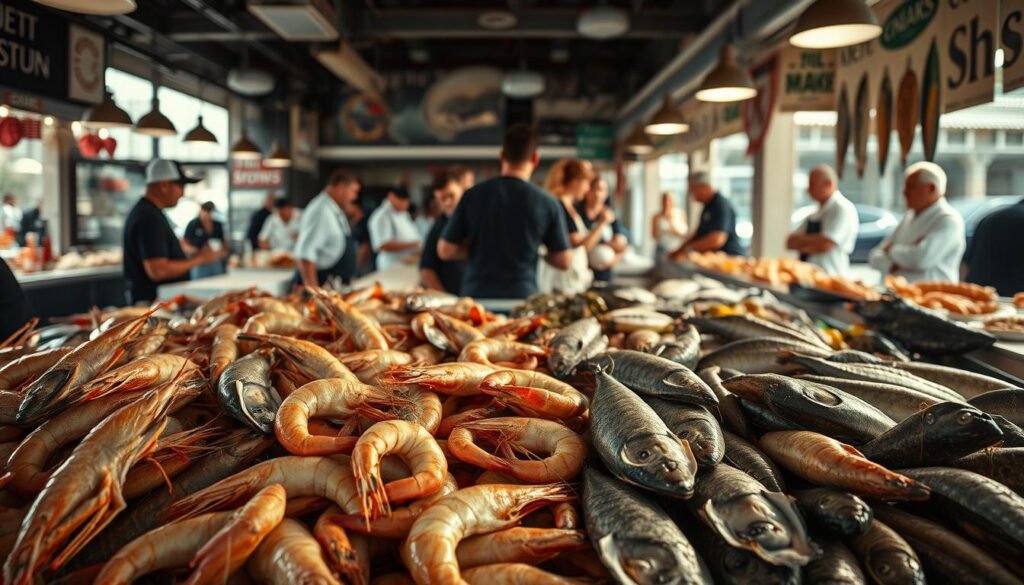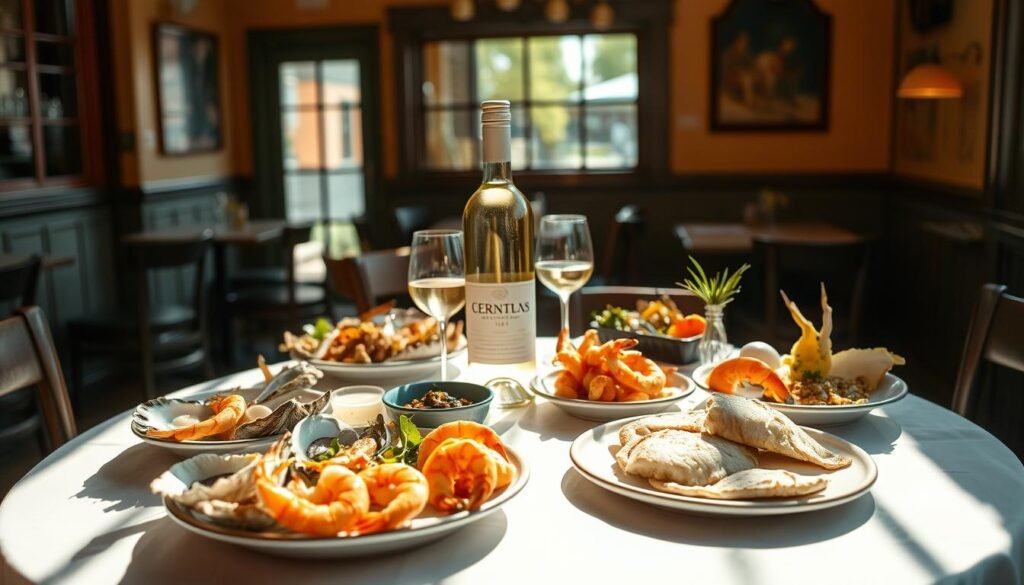As a local, I’m excited to share with you the flavors that make NOLA’s cuisine so unique – a melting pot of traditions that’ll leave you craving more.
From the French Quarter to the surrounding neighborhoods, the city’s culinary scene is a journey through its rich history and cultural heritage. I’ve had the pleasure of savoring these iconic dishes, and I’m eager to guide you through the must-try experiences.
The city’s Creole and Cajun flavors are a true reflection of its cultural identity. In this article, we’ll explore 5 iconic dishes that you can’t miss when visiting NOLA.
Key Takeaways
- Discover the top 5 must-try dishes in New Orleans
- Explore the city’s rich culinary history and cultural heritage
- Learn about the unique Creole and Cajun flavors
- Find the best places to try these iconic dishes
- Get insider tips on experiencing the authentic NOLA cuisine
The Essence of New Orleans Cuisine
At the heart of New Orleans is a cuisine that’s as diverse as its history, blending various cultural traditions. The city’s culinary identity is a reflection of its rich heritage, influenced by French, Spanish, African, and Native American cultures.
The Influence of Creole and Cajun Flavors
New Orleans cuisine is characterized by the bold flavors of Creole and Cajun cooking. Creole cuisine is a sophisticated blend of French, Spanish, and African culinary techniques, often associated with the city’s aristocracy. In contrast, Cajun cuisine is heartier, originating from the Acadian people who settled in rural Louisiana. Both styles have contributed to the rich flavor profile of best New Orleans food.
The use of the “holy trinity” of Cajun and Creole cooking—onions, bell peppers, and celery—forms the foundation of many famous New Orleans dishes. These ingredients, combined with a variety of spices and seasonings, create the distinctive taste that defines New Orleans cuisine.
Unique Cooking Techniques
Cooking in New Orleans is not just about following recipes; it’s an art that involves slow cooking, frying, and layering flavors. Techniques such as making a dark roux, a mixture of flour and fat, are essential for thickening and enriching dishes like gumbo. The slow cooking process allows flavors to meld together, creating a depth that’s characteristic of authentic New Orleans recipes.
Another technique is the use of smoke and heat to add complexity to dishes. Smoking meats and seafood over various types of wood imparts a unique flavor, while high-heat frying creates a crispy exterior that contrasts with the tender interior of fried foods like beignets and fried catfish.
Importance of Local Ingredients
The freshness and availability of local ingredients play a crucial role in New Orleans cuisine. The city’s proximity to the Gulf of Mexico ensures a steady supply of fresh seafood, including oysters, shrimp, and crab. The use of local produce, such as okra and rice, is also integral to many traditional dishes.
The emphasis on local ingredients not only ensures the authenticity of New Orleans dishes but also supports the local economy. By incorporating seasonal produce and fresh catches into their cooking, chefs and home cooks alike can create dishes that are truly representative of the city’s culinary heritage.
Gumbo: A Stew Worth Savoring
Gumbo, the quintessential New Orleans dish, is a flavorful reflection of the city’s cultural melting pot. This hearty stew has been a staple in New Orleans cuisine for centuries, and its rich history is as complex as its flavor profile.
A History of Gumbo in New Orleans
The origins of gumbo are deeply rooted in the city’s cultural heritage, influenced by African, French, Spanish, and Native American cuisines. The name “gumbo” is believed to come from the Bantu word “ki ngombo,” meaning okra, a key ingredient in many traditional gumbo recipes. Over time, gumbo evolved to incorporate various ingredients and cooking techniques, reflecting the diverse backgrounds of New Orleans’ inhabitants.
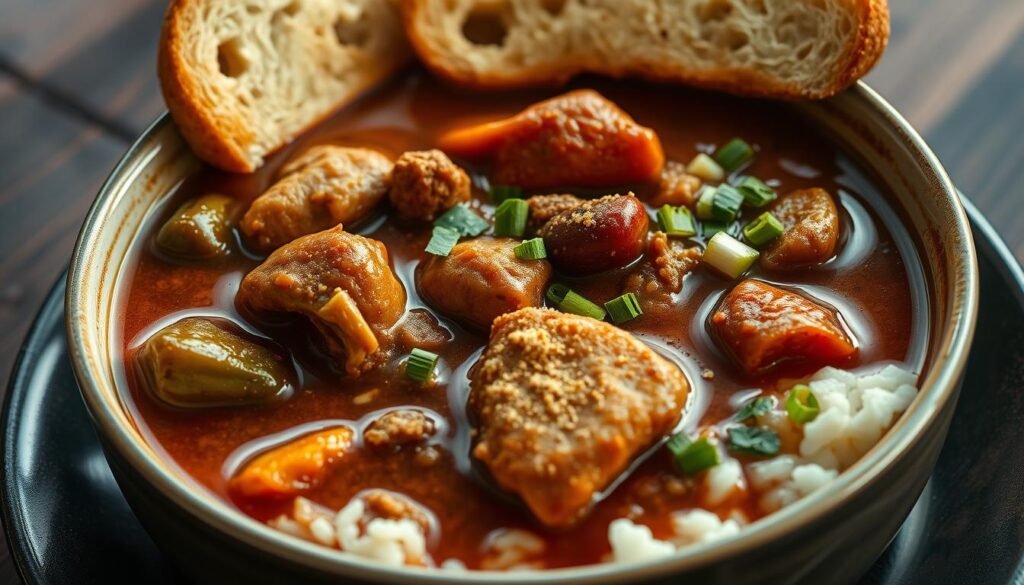
Traditional Versus Modern Variations
While traditional gumbo recipes remain popular, modern variations have emerged, offering creative twists on the classic dish. Some variations include different types of protein, such as seafood or chicken, while others experiment with new ingredients or cooking methods. For a classic gumbo recipe, you can try Chef Jean Pierre’s version, which combines the rich flavors of the traditional dish with a modern touch.
How to Enjoy Gumbo
Gumbo is more than just a meal; it’s an experience. Traditionally, it’s served over rice, which helps to soak up the flavorful broth. Whether you prefer it with okra, filé powder, or a combination of meats and seafood, gumbo is a dish that invites you to explore the depths of New Orleans cuisine. For the best experience, enjoy gumbo in a lively setting, like a jazz club or a family gathering, where the stew can be savored alongside good company and warm hospitality.
Jambalaya: A Hearty One-Pot Wonder
Jambalaya, with its rich mix of sausage, rice, and vegetables, is a true New Orleans culinary gem. This one-pot dish is not only flavorful but also embodies the spirit of New Orleans cuisine – a blend of cultures and flavors. As we explore jambalaya, we’ll dive into its origins, the essential ingredients that make it so delicious, and some serving suggestions to enhance your dining experience.
The Origins of Jambalaya
Jambalaya originated in Louisiana, with its name likely derived from the French word “jambalaia,” meaning “mishmash” or “mix-up.” This dish reflects the cultural melting pot of New Orleans, combining influences from France, Spain, Africa, and the Caribbean. Traditionally, jambalaya was cooked in a large cast-iron pot over an open flame, making it a communal dish perfect for gatherings.
Key Ingredients for the Perfect Jambalaya
The beauty of jambalaya lies in its simplicity and flexibility. Key ingredients include:
- Sausage (Andouille or smoked sausage)
- Rice
- Protein (chicken, shrimp, or a combination)
- Vegetables (onions, bell peppers, tomatoes)
- Spices (cayenne pepper, thyme, oregano)
These ingredients come together to create a dish that’s both hearty and flavorful.
Serving Suggestions and Pairings
Jambalaya is versatile and can be served in various ways. Here are some suggestions:
| Serving Suggestion | Pairing |
|---|---|
| Serve with crusty French bread | Pairs well with a cold beer or iced tea |
| Offer a side salad | Complements the richness of jambalaya |
| Garnish with fresh herbs | Adds a fresh, aromatic flavor |
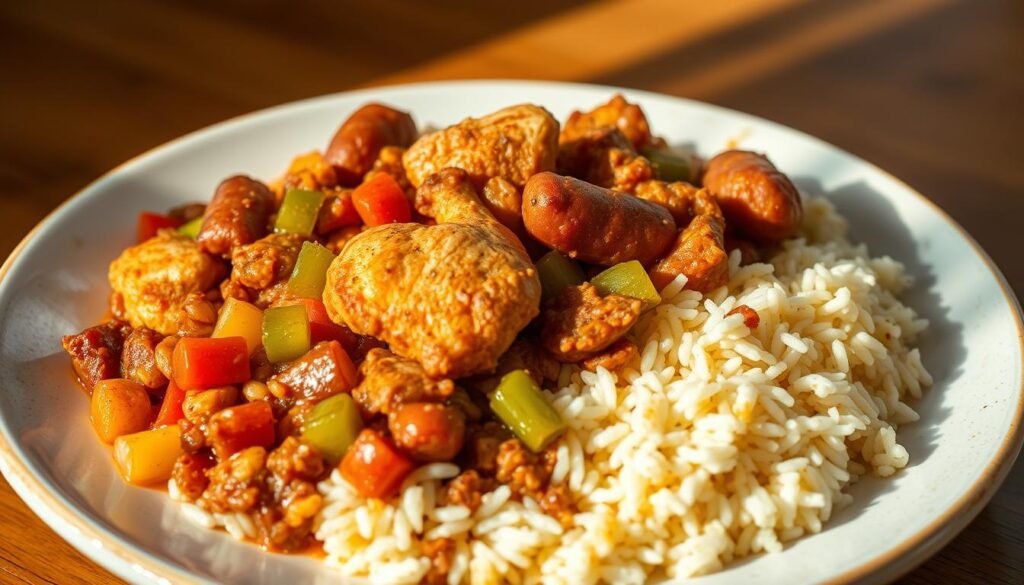
Jambalaya is more than just a meal; it’s an experience that brings people together. Whether you’re a local or visiting New Orleans, this dish is a must-try. With its rich history, flavorful ingredients, and versatility, jambalaya is sure to become a favorite.
Beignets: The Sweet Cloud of New Orleans
Beignets are more than just a sweet treat in New Orleans; they’re an experience that embodies the city’s spirit. These delightful fried dough pastries, covered in a thick layer of powdered sugar, are a must-try when visiting the city.

The Story Behind Beignets
Beignets have a rich history that dates back to the French colonization of New Orleans. They were originally brought to the Americas by French colonists who used yeast to leaven their dough, creating a light and airy pastry. Over time, beignets became a staple in New Orleans cuisine, particularly in the French Quarter.
The famous Cafe du Monde in New Orleans is often credited with popularizing beignets. This iconic cafe has been serving beignets since 1862, and its version remains one of the most beloved. The secret to their success lies in the perfect balance of crispy, fried dough and the sweetness of powdered sugar.
Where to Find the Best Beignets
While Cafe du Monde is a must-visit for beignet enthusiasts, there are other excellent places to try these sweet treats. Here are a few recommendations:
- Cafe Beignet: Known for its creative beignet flavors.
- Morning Call: A historic cafe that has been serving beignets since 1870.
- New Orleans Coffee Company: Offers a variety of beignet styles.
| Location | Notable Feature | Price Range |
|---|---|---|
| Cafe du Monde | Classic Beignet Experience | $10-$15 per person |
| Cafe Beignet | Creative Flavors | $5-$10 per person |
| Morning Call | Historic Ambiance | $10-$15 per person |
Tips for Enjoying Beignets
To fully enjoy beignets, it’s essential to understand the best way to consume them. Here are some tips:
- Order a plate of beignets and enjoy them with a café au lait.
- Be prepared for a generous coating of powdered sugar.
- Try different flavors if available, such as strawberry or chocolate.
Beignets are a quintessential part of the New Orleans experience, representing the city’s rich culinary heritage. Whether you’re a local or just visiting, indulging in these sweet treats is a must.
Po’ Boys: The Ultimate Sandwich Experience
In the heart of New Orleans, there’s a sandwich that’s more than just a meal, it’s an experience – the Po’ Boy. This iconic sandwich has been a staple of the city’s cuisine for decades, offering a delicious blend of flavors and textures that are hard to resist.
What Makes a Po’ Boy Special?
A Po’ Boy is essentially a crispy French baguette filled with a variety of ingredients, ranging from fried seafood to meats. What makes it special is the combination of the crunchy exterior and the soft interior, along with the generous fillings that are often served with a side of tangy pickles and vegetables.
The Bread: The foundation of a great Po’ Boy is its bread. Traditionally, it’s made from a French baguette that’s been lightly toasted or fried to give it a crispy crust.
The Fillings: From fried oysters and shrimp to roast beef and catfish, the fillings are where the magic happens. Each ingredient is carefully prepared to bring out its unique flavors.

Popular Fillings and Their Origins
Po’ Boys can be filled with a wide range of ingredients, each with its own story. Some of the most popular fillings include fried seafood, roast beef, and fried catfish. These ingredients are often locally sourced and prepared using traditional methods.
- Fried Oysters: A Southern favorite, oysters are breaded and fried to perfection.
- Roast Beef: Slow-cooked beef that’s tender and flavorful, often served with gravy.
- Fried Catfish: A classic Southern dish, catfish is breaded and fried until crispy.
Best Places to Try Po’ Boys
New Orleans is home to numerous eateries serving Po’ Boys, each with its own twist. Here are a few places to try:
| Restaurant | Notable Po’ Boy | Price Range |
|---|---|---|
| Parkway Bakery and Tavern | Fried Shrimp Po’ Boy | $15-$20 |
| Dooky Chase’s Restaurant | Roast Beef Po’ Boy | $10-$15 |
| Mother’s Restaurant | Fried Catfish Po’ Boy | $12-$18 |
As you explore the city, be sure to try a Po’ Boy at one of these iconic eateries. Whether you’re a local or just visiting, the Po’ Boy is an experience you won’t want to miss.
Étouffée: A Rich and Flavorful Dish
New Orleans is known for its vibrant cuisine, and among its famous New Orleans dishes, Étouffée stands out as a rich and flavorful stew. This beloved dish is a staple in Creole cuisine, reflecting the city’s cultural melting pot.
At its core, Étouffée is a stew made with a combination of ingredients, typically including seafood, vegetables, and a roux-based sauce. The name “Étouffée” translates to “smothered” in French, which refers to the cooking technique of smothering the ingredients in a rich and flavorful gravy.
Understanding the Basics of Étouffée
The foundation of a great Étouffée lies in its roux, which is a mixture of flour and fat. The roux is cooked to a dark brown color, giving the stew its characteristic flavor and color. The choice of seafood, whether it’s shrimp or crawfish, significantly influences the dish’s overall taste and texture.
Differences Between Shrimp and Crawfish Étouffée
While both shrimp and crawfish are used in Étouffée, they offer distinct experiences. Shrimp Étouffée is often milder and can be slightly sweeter, depending on the shrimp’s origin and preparation. Crawfish Étouffée, on the other hand, has a more robust flavor, with the crawfish adding a richer, more complex taste to the dish.
The choice between shrimp and crawfish Étouffée often comes down to personal preference. Some locals prefer the heartier flavor of crawfish, while others enjoy the tender taste of shrimp.
Recommendations for Tasting Étouffée
For an authentic Étouffée experience, head to local eateries in New Orleans that specialize in Creole cuisine. These establishments often have their own secret recipes and techniques that have been passed down through generations.
When trying Étouffée, pay attention to the balance of flavors and the tenderness of the seafood. A well-made Étouffée should have a rich, velvety sauce that complements the seafood without overpowering it.
Whether you’re a local or just visiting, Étouffée is a delicious New Orleans specialty that showcases the city’s culinary heritage. It’s a dish that’s sure to leave you wanting more of the city’s famous flavors.
Muffuletta: A Flavorful Italian-American Classic
The Muffuletta sandwich, with its round, crusty bread and flavorful fillings, is a classic New Orleans dish worth savoring. This iconic sandwich is a testament to the city’s rich Italian-American heritage, blending the best of both worlds in every bite.
The Story Behind Muffuletta
Muffuletta’s history is deeply rooted in the Italian-American community of New Orleans. The sandwich was created in the early 20th century by Salvatore Lupo, the owner of Central Grocery Co. on Decatur Street. Lupo catered to the local Sicilian community by combining cured meats, cheese, and olive salad between a round, crusty bread loaf. This creation was not only a reflection of the community’s culinary traditions but also a practical solution for workers looking for a filling meal.
What Makes a Muffuletta Authentic
So, what makes a Muffuletta truly authentic? The essential ingredients include a round, crusty Muffuletta bread, cured meats like ham and salami, provolone cheese, and most importantly, the olive salad. The olive salad, made with chopped olives, celery, and cauliflower, is marinated in olive oil, giving the sandwich its distinctive flavor. The combination of these ingredients creates a harmonious balance of flavors and textures that define the Muffuletta experience.
- Round, crusty Muffuletta bread
- Cured meats (ham, salami)
- Provolone cheese
- Olive salad (olives, celery, cauliflower, olive oil)
Where to Find the Best Muffuletta
For an authentic Muffuletta experience, head to Central Grocery Co., the birthplace of this iconic sandwich. Other notable spots include:
- Parkway Bakery and Tavern
- Dooky Chase’s Restaurant
- Coop’s Place
These establishments offer their own twists on the classic recipe, ensuring that every Muffuletta lover can find a version that suits their taste.
Sweets and Desserts: A Taste of New Orleans
The Big Easy’s dessert landscape is a rich tapestry of Creole delights, French pastries, and Southern charm. New Orleans is renowned for its sweet treats, which are as much a part of the city’s culinary identity as its savory dishes.
Iconic Desserts You Can’t Miss
When visiting New Orleans, there are certain desserts that you simply can’t miss. Beignets are a classic, covered in a thick layer of powdered sugar and best enjoyed with a café au lait at Café du Monde. Another favorite is Bananas Foster, a decadent dessert made with bananas, brown sugar, and rum, flamed at the table.
Bread pudding is another staple, often served with a whiskey sauce that adds a depth of flavor. And let’s not forget about King Cake, a sweet bread traditionally enjoyed during Mardi Gras season, filled with cinnamon and topped with icing and sugar.
The Role of Festivals in New Orleans Sweets
New Orleans is famous for its festivals, and many of these celebrations center around food, including sweets. The New Orleans Jazz & Heritage Festival features a variety of sweet treats, from beignets to pralines. During Mardi Gras, King Cake is a central dessert, symbolizing the city’s festive spirit.
These festivals not only showcase the city’s love for sweets but also provide a platform for local bakeries and chefs to innovate and share their creations.
Where to Indulge Your Sweet Tooth
New Orleans is dotted with bakeries, cafes, and restaurants that serve up incredible desserts. For beignets, Café du Monde is a must-visit. For a more modern take on Bananas Foster, head to Brennan’s Restaurant. If you’re in the mood for something different, Morning Call in the French Market offers beignets 24/7.
Whether you’re a local or just visiting, New Orleans’ dessert scene is sure to leave you with a sweet tooth and a deeper appreciation for the city’s culinary delights.
Beverages to Complement Your Meals
From classic cocktails to unique local brews, New Orleans offers a diverse range of beverages to enhance your dining experience. Whether you’re savoring delicious New Orleans specialties or enjoying famous New Orleans dishes, the right drink can elevate your meal to new heights.
Traditional New Orleans Cocktails
New Orleans is the birthplace of some of the world’s most iconic cocktails. The Sazerac, made with rye whiskey, absinthe, and Peychaud’s Bitters, is a must-try. It’s a drink that’s as much a part of the city’s history as its famous New Orleans dishes. Another favorite is the Pimm’s Cup, a refreshing mix of Pimm’s No. 1, a gin-based liqueur, and lemonade, garnished with cucumber and mint.
Coffee Culture in New Orleans
Coffee is an integral part of New Orleans culture, with a history that dates back to the city’s founding. Café au Lait, made with coffee and scalded milk, is a staple. You can enjoy it at one of the many historic cafes, like Café du Monde, where you can watch beignet-making and savor the rich flavors. The city’s coffee culture is a perfect complement to its delicious New Orleans specialties.
Unique Local Beverages to Try
Beyond cocktails and coffee, New Orleans has a range of unique beverages worth trying. Abita Beer, brewed locally since 1986, offers a variety of flavors that pair well with the city’s cuisine. You can also try Hand Grenade, a sweet and potent cocktail that’s a favorite among locals and visitors alike.
| Beverage | Description | Pairing Suggestions |
|---|---|---|
| Sazerac | Rye whiskey, absinthe, Peychaud’s Bitters | Gumbo, Jambalaya |
| Pimm’s Cup | Pimm’s No. 1, lemonade, cucumber, mint | Seafood, salads |
| Café au Lait | Coffee, scalded milk | Beignets, pastries |
Dining Experiences in the Big Easy
New Orleans is a city that lives and breathes food, and dining here is an experience like no other. The city’s culinary landscape is a vibrant tapestry woven from its rich cultural heritage, with each dish telling a story of tradition and innovation.
Tips for Finding Authentic New Orleans Cuisine
To truly experience the flavors of New Orleans, it’s essential to seek out authentic local cuisine. Look for restaurants and eateries that are popular with locals, as these often serve the most traditional and delicious dishes. Be sure to try some of the city’s iconic dishes, such as gumbo, jambalaya, and beignets, which are staples of the New Orleans culinary scene.
When searching for authentic New Orleans cuisine, don’t be afraid to venture off the beaten path and explore different neighborhoods, such as the French Quarter or Treme, where you’ll find a wealth of local eateries and hidden gems.
Popular Food Tours to Consider
One of the best ways to experience the culinary delights of New Orleans is by taking a food tour. These guided tours take you on a culinary journey through the city’s most iconic eateries, markets, and hidden gems, offering a taste of the city’s diverse culinary heritage. From the French Quarter to the Garden District, food tours provide a unique perspective on the city’s food culture and history.
Some popular food tours to consider include the New Orleans Food Tour, which takes you on a culinary journey through the city’s most iconic dishes, and the French Quarter Food Tour, which explores the historic French Quarter’s culinary delights.
The Importance of Local Dining Etiquette
When dining in New Orleans, it’s essential to understand the local dining etiquette to fully appreciate the culinary experience. New Orleans is known for its hospitality, and mealtimes are often seen as opportunities to connect with others and enjoy good company.
Some key dining etiquette tips include being respectful of the servers and staff, trying new dishes and flavors, and engaging with the local culture. By embracing these customs, you’ll be able to fully immerse yourself in the New Orleans dining experience and create lasting memories.
Conclusion: A Culinary Adventure Awaits
New Orleans is a city that will forever be etched in your memory – a place where flavors, traditions, and warmth come together to create an unforgettable culinary experience. From the rich, velvety gumbo to the sweet, powdered beignets, every dish tells a story of the city’s cultural heritage.
Savoring the Flavors of New Orleans
As you explore the best New Orleans food, you’ll discover that each dish is a reflection of the city’s history and the people who call it home. Be sure to try authentic New Orleans recipes, like jambalaya and étouffée, which showcase the city’s unique blend of Creole and Cajun flavors.
Exploring Beyond the Plate
New Orleans is more than just a meal – it’s an experience. Take a stroll through the French Quarter, visit iconic eateries, and engage with the locals to get a true taste of the city’s warmth. Whether you’re a food enthusiast or just looking to try something new, the city’s culinary scene has something to offer everyone.
So, come and indulge in the best of New Orleans cuisine. Let the flavors transport you to a world of delight, and discover why this city remains a top destination for food lovers from around the world.
FAQ
What are the must-try dishes when visiting New Orleans?
When visiting New Orleans, be sure to try the iconic dishes like gumbo, jambalaya, beignets, Po’ Boys, étouffée, and Muffuletta – they’re a representation of the city’s rich culinary heritage.
What’s the difference between Creole and Cajun cuisine?
Creole cuisine is a blend of French, Spanish, African, and Native American flavors, typically found in New Orleans, while Cajun cuisine originated from the Acadian people and is often associated with rural Louisiana – both are characteristic of New Orleans’ diverse culinary scene.
Where can I find the best beignets in New Orleans?
Cafe du Monde is a legendary spot for beignets, but you can also try Morning Call or Cafe Beignet for a delicious powdered sugar treat.
What’s the story behind Po’ Boys?
Po’ Boys originated in the 1920s as a sandwich filled with fried oysters or shrimp, typically served on a crispy French baguette – it’s a staple in New Orleans cuisine.
Can I customize my étouffée order?
Yes, you can usually ask for your étouffée to be made with shrimp, crawfish, or a combination of both – just let your server know your preference.
What’s the best way to experience New Orleans cuisine?
To truly experience New Orleans cuisine, try taking a food tour, visiting local eateries, and sampling the city’s iconic dishes – you’ll get a taste of the city’s rich cultural heritage.
Are there any vegetarian or vegan options in New Orleans cuisine?
While traditional New Orleans cuisine is often meat-based, many modern restaurants now offer vegetarian and vegan options – be sure to ask your server for recommendations.
What’s the significance of coffee culture in New Orleans?
Coffee is an integral part of New Orleans culture, with many locals starting their day with a cup of coffee at a traditional coffeehouse – it’s a great way to experience the city’s laid-back atmosphere.
